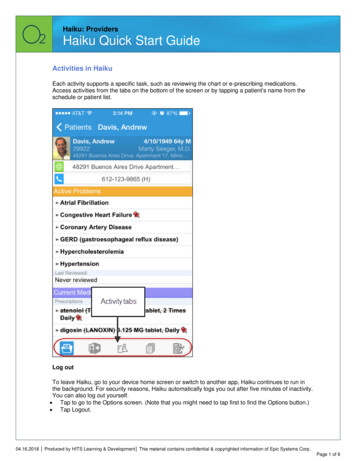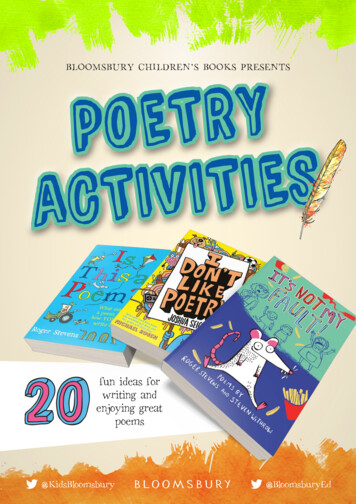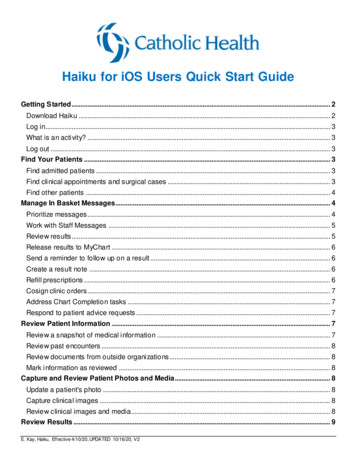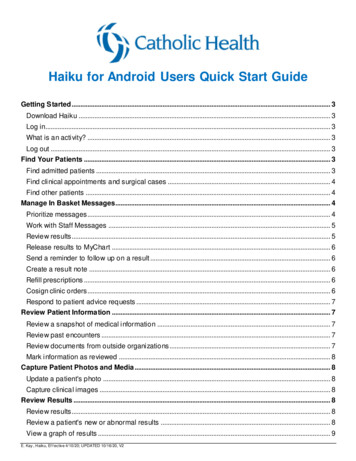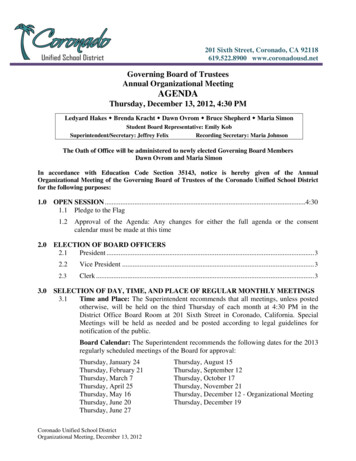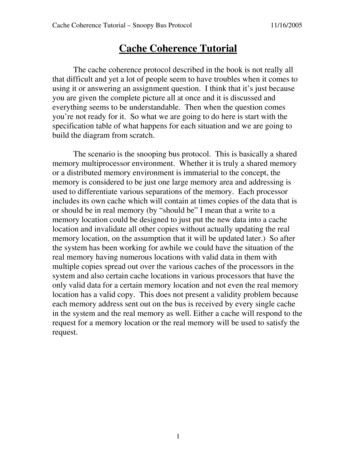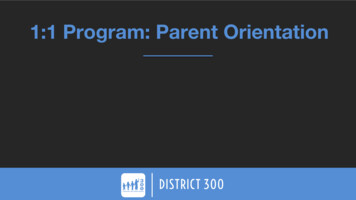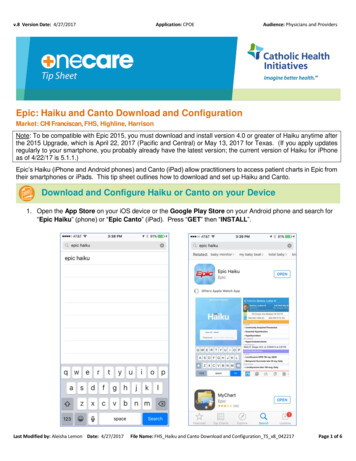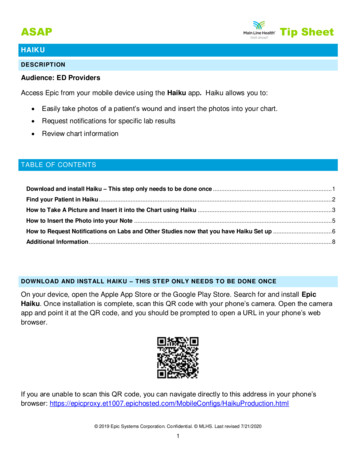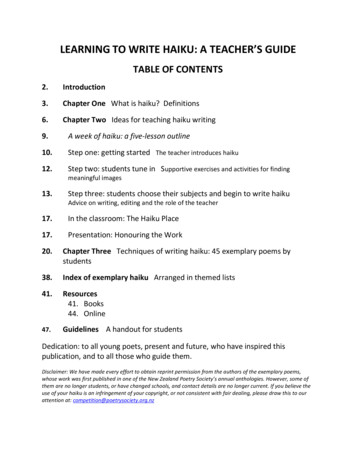
Transcription
LEARNING TO WRITE HAIKU: A TEACHER’S GUIDETABLE OF CONTENTS2.Introduction3.Chapter One What is haiku? Definitions6.Chapter Two Ideas for teaching haiku writing9.A week of haiku: a five-lesson outline10.Step one: getting started The teacher introduces haiku12.Step two: students tune in Supportive exercises and activities for findingmeaningful images13.Step three: students choose their subjects and begin to write haikuAdvice on writing, editing and the role of the teacher17.In the classroom: The Haiku Place17.Presentation: Honouring the Work20.Chapter Three Techniques of writing haiku: 45 exemplary poems bystudents38.Index of exemplary haiku Arranged in themed lists41.Resources41. Books44. Online47.Guidelines A handout for studentsDedication: to all young poets, present and future, who have inspired thispublication, and to all those who guide them.Disclaimer: We have made every effort to obtain reprint permission from the authors of the exemplary poems,whose work was first published in one of the New Zealand Poetry Society’s annual anthologies. However, some ofthem are no longer students, or have changed schools, and contact details are no longer current. If you believe theuse of your haiku is an infringement of your copyright, or not consistent with fair dealing, please draw this to ourattention at: competition@poetrysociety.org.nz
IntroductionThis guide to writing haiku has been prepared with primary, intermediate and high schoolteachers in mind. Our aim is to support teachers by presenting information on how to composehaiku as it is currently written worldwide, so in turn they can skilfully support their students todiscover the enjoyment of haiku. This document may also be useful for independent studentsof any age.Poetry writing is an under-appreciated pursuit which can be a deeply pleasurable way ofconsidering life – sharing poignant moments through haiku is rewarding for both writer andreader. We present here some ways of creating a “poetry culture” in the classroom toencourage this kind of communication. If using this guide results in more young peopledelighting in composing haiku, wonderful! If more of them are confident to submit and sharetheir work, even better!I was fortunate to be the judge for the 2015 Junior Haiku Competition of the New ZealandPoetry Society and was amazed at the quality of the majority of submissions. Clearly, youngpeople are just as capable of writing truly excellent haiku as adults – I could see that there isreally no such thing as ‘children’s haiku’. So, as a basis for this guide, I feel no need to look towell-known adult examples of haiku. Instead, I have chosen to comment on prize-winningentries from recent Junior Competitions, each of which exemplifies one or more specificqualities of haiku with terrific impact.This guide is a living document. We ask anyone who uses it – or teachers who have alreadydeveloped their own successful haiku-teaching programmes – to send their comments, so thatin future years it becomes a collaborative document presenting a range of ideas that works wellfor teachers and students both. Thank you to all participants in this project.Katherine RaineNew Zealand Poetry SocietyFebruary 20162
Chapter One What is haiku? DefinitionsFor immediate reference in getting started, here are three lists concerning the characteristics ofhaiku (hi-coo) as it is now written in English. These points will be covered in more detail in mycomments on each exemplary haiku.What haiku is:One basic definition of a haiku poem is: a personally-significant moment conveyed by one ortwo images and presented in a small number of words. The essence is the same whetherwritten by young people or adults. This kind of poem is: honestvivid and immediatewritten in the present tense, in the here and nowas specific as possiblebased on the sensesabout events in the everyday world, ‘things as they are’as brief as possiblemade of just one or two imagesformed of two parts, one short and one longer, with a definite break between thepartswritten in plain languageWhat haiku is not:Outdated ideas and misconceptions about haiku abound. Haiku has moved on into newterritory, leaving behind most of the conventional ideas about it. Also, it is very unliketraditional Western poetry. These days we can assert that haiku is: not 17 syllables arranged in three lines of 5-7-5 syllables respectivelynot only about naturenot necessarily about beauty or a “nice” positive, easy-reading subjectnot sentimental or explicitly emotionalnot exotically ‘Oriental’, despite its Japanese originnot a narrativenot a fantasynot structured by metre (rhythm)not rhymednot made choppy by removing every “a”, “an” and “the”not a place for simile, personification or obvious metaphornot a place for general concepts or intellectual musingnot given a title3
What is optional in haiku:Haiku is written in many different ways all over the world in the 21st century, so there is a widerange of approaches, from the traditional to the avant-garde. We are no longer trying to imitatethe style of early translations from the Japanese, but have made haiku “our own”, no matterwhere we live. The poet is now free to pick and choose among many possibilities to suit theirsubject and their inclinations. The options (to use or not) include: a word indicating the season, though it is common to use onea tone of sadness or lonelinessuse of repeated sounds that contribute to the meaninga sense of humour or witthe stated presence of “I” the poeta syllable count between 3 and 17 (though 17 is considered both old-fashioned andtoo long by most authorities; 14 is now seen as reasonably long)three lines (can be one or two, very occasionally four)a different arrangement of three lines, not necessarily making the first and thirdshorter, the middle one longerwords of the haiku arranged freely and expressively on the pagea surprise in the last line or last phraseno punctuation or capitalizingfew, if any, descriptive adjectives or adverbs; overuse of these is a common faulta full sentence or sentences; most often a haiku is made from phrases onlyAlso not essential is the experience of the traditional ‘haiku moment’. Many people believe thata haiku happens only when, in a mystical flash of inspiration, the poem comes to you completeand perfect. This is a very limiting belief! Thoughtfully crafting and editing haiku is absolutelyokay and very common. Trying out alternative versions, paring down a poem, or polishing it,can all be satisfying and worthwhile stages in making an authentic haiku.Chapter Three, Techniques of Writing Haiku, will expand on the Definition lists. It introduceshaiku in detail through my comments on 45 haiku from previous Junior Haiku Competitions. Butbefore you go on to Chapter two on teaching methods, here is a sampler of five haiku thatdemonstrate many of the characteristics of skilful, authentic haiku outlined above.1. springthe calfcomes aliveNicholas SharrBrevity (just 6 syllables); simplicity and plain language; present tense; development of dramaword by word; an ‘openness’ that does not tell readers what to feel, instead allowing us todiscover our own emotions.4
5. winter morningI stir a rainbowIn my potLily PringleImagination and originality; surprise; zooming in from the winter scene to the pot; connectingthe elemental and domestic realms; contrast of ethereal and earthy; unsentimental rainbowimagery.15.wild boarthe gun shuddersin my handAmelia GordonThe power of the key word, “shudders”; vivid direct perception of a sense of touch; evokingemotion without telling us what to feel; mystery about what happened (was the gun fired ornot?), so readers can decide for themselves.23.7 years of droughta single raindropdisturbs the dustAmy WellsA large-scale situation represented by a tiny, specific happening; the repeated sound(alliteration) of /d/ in each line, which when the haiku is spoken, feels in the mouth and soundslike the impact of the rain on the ground.33.broken icereflectingmy imageCharlotte Trevella (11)Unusual arrangement of the lines on the page, expressive of the subject; middle line connectsnature and human nature; melancholy tone.5
Chapter Two Ideas for teaching haiku writingA very short poem needs to be very sharp to touch us. Its brevity and focus give it a keen point.The most amazing quality of haiku is its ability to open us to the biggest subjects with just a fewwords about something small. The touching of the reader – who may be of a different age andnationality to the writer – comes through employing the senses and emotions, rather thanintellectual generalities.A haiku handbook written by two eminent poets opens with the question, what are haiku for?Their answer is clear – for sharing a personally significant moment: “When we compose a haiku,we are saying, ‘It is hard to tell you what I am feeling. Perhaps if I share with you the event thatmade me aware of these feelings, you will have similar feelings of your own ’ The central act ofhaiku is letting an object or event touch us, and then sharing it with another. If we are thewriter, we share it with the reader. If we read a haiku, we share that moment, or one like it,with the writer.”1The first criterion for haiku, then, before any concerns with technique, is sincerity. Teachingyoung people to write haiku will really work only if they are encouraged to present experiencesthat are genuine and personally meaningful, rather than superficially correct forms in fulfilmentof an assignment. In this guide, my basic challenge has been to find ways to promoteauthenticity in writing. Once students are enthusiastic about their subject, then the technicalconsiderations come more easily and naturally to support expressiveness.Over the years, talented teachers working individually have invented and refined effectivemethods of teaching haiku to students of all ages, with great results. For teachers who want totry haiku in the classroom, what information from these experienced teachers is available toinspire and support you?Initially I did a search online and in the library, to see what resources could be readily accessed.I assumed there would be good lesson plans galore. I discovered some excellent onlineresources for lesson plans, as well as a couple of books written for children on how to composehaiku, which you could use as a basis for your own lesson planning. (See Resources for moreabout all these.) However, surprisingly little else came to light. Often the advice seemed to beaimed at haiku poets visiting a school to present a ‘workshop’ for an hour or so. The threeoutstanding sources I could find of teaching materials on haiku writing are:1. The British Haiku Society provides a wonderful, 20-page, downloadable Teaching Pack,material enough to cover a few sessions in the classroom, for ages 9 – 16. It gives achoice of two introductory 50-minute lesson plans plus ideas for extending these, soteachers can design their own programmes according to their teaching style and thetime available to them.1What haiku are for: Higginson, W.J. and Penny Harter, The Haiku Handbook, pp. 4-6.6
2. The Haiku Foundation presents very structured and detailed Haiku Lessons foryears/grades 1-6, along with exemplary poems (from its archives) on which the plansare based. These plans are first rate, having been created by an eminent haiku writeralong with an educator with a Ph.D. In general for each age group, there are a fewdays’ plans of 30 minutes each: introduction, writing haiku and revising. Severalalternative ideas are given for each plan. For years/grades 7-12, a briefer, looser set ofideas and resources from their archive is provided.3. Patricia Donegan's book, Haiku: Asian Arts and Crafts for Creative Kids, introduceshaiku with 7 keys to writing poems and 5 projects. Although written for children, itprovides a concise and authoritative basis for lesson planning (one to two pages, withexemplary poems, for each key point). The appealing exemplary poems range fromtraditional Japanese to Western to children's from around the world. Projects includehaiga (artwork with haiku), with examples by children, and making a haiku-sizedbooklet for poems. The author is a well-known haiku poet and translator.Recommended for ages 7-12, but could be extended, I think, to 14 at least. Ninecopies of this book are currently held by New Zealand libraries, including the NationalLibrary for free borrowing.Not being able to simply recommend a wide range of lesson-planning options, I am insteadimagining (from the viewpoint of a poet rather than an experienced school-teacher) howgenuine, exciting haiku-writing could be taught.I visualise a more in-depth approach by classroom teachers, taking more than the minimalthree days of the lesson plans above. Haiku can be so much more than a little literacy exercise,or just a ‘fun’ way of putting a few words into a certain form for half an hour. Potentially haikuhas a much greater and deeper value, as a way of keenly perceiving the world, of payingattention to what is personally meaningful, then finding a way to express and share that inessence. So what follows are mainly my own ideas for a way of creating a ‘poetry culture’ –over as generous a time period as possible – in the classroom.Below I have outlined a process for entering the realm of haiku, with three steps:1. the teacher introduces the topic of haiku, beginning with reading some aloud, andopens discussion about what it is2. students do activities that will help them tune into their senses and collect images thatare meaningful to them3. students choose their theme and begin to write; if needed, they can do some exercisesand activities to get their poem-composing startedRealistically, you may not have an extensive time-frame. In the next section is A Week of Haiku:a five-lesson outline, giving a five-day process for following these steps. The different activitieson the outline are described more fully below. One way to cover the topic of haiku writing evenmore briefly, in three days, is by doing the lesson plans for Day One, Day Three and Day Five.7
There is certainly plenty of scope in my ideas, and in the exemplary haiku themselves, toexplore over a longer time. In any case, my ideas in this chapter are loosely organised, withvarious options, so you can use them creatively, according to your own classroom style andcircumstances.Haiku has instant appeal – even if you choose only a few among the following activities, it ishighly likely that the haiku experience will be engaging, enjoyable and worthwhile for you andyour students. Several teachers have commented that in their experience, good haiku writingcertainly does not require a student to be a ‘poet-type’ person, and that most people can write2good haiku in their first attempts.The only essential pieces of equipment are a haiku notebook and pen or pencil for eachstudent. The notebook will have multiple uses throughout the haiku sessions.2Ease of learning to write haiku: Reichhold, J., Writing and Enjoying Haiku, p. 100-101; Haiku Society ofAmerica website, Martin, J., ‘Some thoughts on teaching and learning haiku’, p. 1.8
A Week of Haiku: a five-lesson outlineDAY ONE: Introducing haiku by reading aloud the teacher reads aloud examples listed in Section One of the Index the teacher elicits a class discussion on what haiku is and how it works Homework: students start searching for images, with The Five Senses or SeasonWords exercises (or a combination of the two)DAY TWO: Gathering meaningful images A. the class takes a Haiku Walk, with each student noting images OR B. the teacher has prepared a set of haiku from the Index from which eachstudent chooses a favourite to present to the class; these could include examplesfrom Section One, Haiku to See on the Page, as well as those from Section Two,such as Senses Other Than Vision and Haiku Suggesting Various Emotions Homework: students collect their own meaningful imagesDAY THREE: Writing haiku the teacher opens by handing out a Guidelines Sheet (see page 47) each student chooses a favourite subject from their images and begins writing anyone who is having trouble getting started can do an exercise (Zooming In andOut, or Similarity and Contrast) to help them assemble some imagery Homework: students continue writing at homeDAY FOUR: Writing and revising haiku the teacher does a brief warm-up reading of a few appropriate haiku fromSection Two of the Index, such as Techniques or Sensory Vividness students continue writing and begin to revise, using the Guidelines Sheet Homework: students complete revisions and choose their best haiku to presentto the class the next dayDAY FIVE: Presenting the work A. Students choose at random another student’s haiku and reads it aloud to theclass, following the suggestions in Group Reading The teacher encourages discussion of what was enjoyable about each haiku OR B. Each student makes a booklet of a few of their own best haiku, or mounts afavourite on a creative backing sheet; these can be displayed in the classroomOR C. The class works on assembling a classroom anthology with haiku from eachstudent9
Step one: getting startedThe teacher introduces haikuIntroducing haiku first through listening: According to most poet/teachers, the best way tobegin with haiku is for the teacher to read some examples.3 Listening is the first skill to buildwhen entering the world of haiku, learning to pay attention to individual words and theirpowers. Hearing haiku aloud is a wonderful way to experience them, whether they are yours orthe work of another, so I will say more later about carrying on reading haiku aloud.When you read haiku to your class, I suggest doing this very slowly, perhaps repeating them,with the bare minimum of introductory remarks. You may need to introduce the concept of animage (a picture created by words, about any of the five senses). After reading the first fewhaiku, start a discussion by asking students to describe their qualities. Begin to focus on eachimage in the haiku – what is it?, where does it come from (the immediate experience of thesenses, or memory, or imagination?), what did this one make you feel?, how did it do that?Then read more haiku aim to let the insights come from the students, instead of your tellingthem what it’s all about.With this introductory reading and listening in mind, in Chapter Three I have chosen 45 haikuthat are suitably inspiring and thought-provoking. It should be reassuring for your students toknow that these have all been written by young people, not adult ‘experts’. After the exemplarypoems is an Index of all the haiku, grouped in themed lists. Section One of the Index is forintroducing haiku. The first list is of those most suitable for introductory reading aloud becauseof their themes. This will aid you in choosing selections from the exemplary haiku according tosubject. The haiku are so varied that you should be able to find exemplars that suit the agegroup of your students and even any particular interests they may have from other subjectsthey are studying (e.g. nature or weather).By hearing some of these haiku, students should quickly get a sense of the specifics of how thiskind of poetry works and be able to participate in fruitful discussion of how each one is similarand/or different. This is a good chance to present the importance of the sounds of the wordsand also the silent moments where there is a space in the written line. Poems that have specialhaiku qualities for the ear are also listed in Section One of the Index.Another good starting point is the list of haiku with a New Zealand theme. These haiku willallow students to see familiar activities, scenes, plants and animals in the context of poetry.3Beginning by reading aloud: Higginson, W.J. and Penny Harter, The Haiku Handbook, p. 156 (William) and pp. 167168 (Penny); Reichhold, J., Writing and Enjoying Haiku, p. 101; Haiku Foundation website, lesson plans; HaikuSociety of America website, Martin, J., ‘Some thoughts on teaching and learning haiku’; Davidson, K., NZ haikuteacher, interviewed by N. Borrell in a fine line, magazine of the NZPS, May 2007.10
Other sources of haiku on these subjects can be found in the New Zealand haiku anthology, thetaste of nashi, and in the Showcase feature on the NZPS/HaikuNewZ ducing haiku in written form: Showing written poems early on, by means of whatevermedia is practical for you, is also essential. Seeing them will introduce the art involved inpresenting the words of the haiku on the page in a way that adds to its meaning. I have noticedthat young people are more daring about using expressive arrangements of words and linesthan adult haiku-writers. (Many of the latter seem to be stuck on using three lines, short-longshort, each aligned at the left margin.) Section One of the Index also lists poems to see on thepage, which look intriguing, so are among the best to present in print form.Providing guidelines: To conclude your introduction to haiku and introduce the students towriting their own, hand out a written summary or outline of the form for them to refer to whilewriting. You could include some of their ideas arising from the discussion of haiku read aloud.The Guidelines Sheet at the end of this guide, or something similar, can also be useful whenstudents are revising their poems.4Choosing favourites: If time allows, more activities based on the work of other poets can beincluded, as group discussion, written work in class or homework, or even artwork. You canextend the pleasures of reading aloud by having each student choose his or her own favouritehaiku and present it to the class. Some other sources of haiku, in print and online, for studentsto explore are found in Resources. I especially recommend those in the British Haiku SocietyTeaching Pack, which gives both traditional Japanese and contemporary English-languageexamples. As an alternative to reading aloud, students could present their favourite haiku inwritten form in a mini-essay. Abstract artwork expressing ‘how this haiku makes me feel’ couldbe an enjoyable part of this assignmentNoting down favourite haiku is a good first use of the haiku notebook. The best use of these isfor analysis (not ‘copying’!). When they have found a haiku whose technique or feeling theyadmire, they can look at just how the haiku works and apply these insights to their own themes.Students could also post their favourites in the classroom, as discussed below in The HaikuPlace, a good way to share their enthusiasm.4Guideline points selected and expanded from several sources: Harter, P., The Haiku Handbook, her 3-pointchecklist on pp. 173-4; Macken, J.E., Read, Write and Recite Haiku, her 5-point checklist on p. 28; Reichhold, J.,Writing and Enjoying Haiku, her 6 basic rules on p. 52.11
Step two: students tune inSupportive exercises and activities for finding meaningful imagesFirst, here are a few ideas for encouraging students to begin opening up their sensoryawareness. These exercises can spark off the poetry making and in a more general way light upthe creative areas of the brain.The Sensory Diary – students tune in to what is happening in their own worlds: Haiku aremost often based on strong imagery directly perceived by the senses. Brain research hasshown that generally, less than 10% of stimuli received by our senses make it into ourconsciousness. So, making haiku usually depends on becoming more aware. I suggest thatstudents all use their haiku notebooks freely to record whatever grabs their attention; sooften this is surprising, fresh and unique to each person.The Five Senses: This could be a homework assignment, or impressions could be notedduring the school day. Tell students to find five strong sensory experiences; list them andwrite briefly why it impressed them. If you have time, start with vision on day 1, hearing onday 2, and so on. Or on a single day, have them find a vivid experience from each of the fivesenses.Season Words: To help students tune in to the details of their environment, have them findand list five seasonal things, one for each sense (something they directly perceive, not makeup, e.g., not spring birds nesting, unless they actually see a nest). A season word isessential in a traditional haiku. While not required in contemporary Western haiku, it doesenrich a poem very effectively and efficiently. New Zealand has unique seasonal features, towhich we respond emotionally, so it is good to appreciate and use them in our poetry. A listof all the gathered season words could become a useful class resource.Multiple Happenings in a Moment: Once students become more mindful of what is actuallygoing on with their sensory experience, they will probably notice that a lot can happen in asingle moment. Again, students should find and record five experiences each day, ideally forseveral days. Each experience would consist of a strong sensory impression plus anynumber of other things that were noticed at the same time. For example, the sweetness ofa food AND its colour or texture, or sounds in the room, or what someone else was doing,an emotion felt by the student, a memory or an association that comes to mind. A haiku ismost often made of two images together, so this exercise gets students started in pairingexperiences and noticing unexpected connections, as well as finding the emotion that ispart of a perception. A haiku that touches more than one sense is often wonderfullyappealing.Then, as groundwork for choosing a subject, students can begin to focus on imagery thatparticularly interests them.Collecting Images – students tune in to what is significant to them: To initiate writing, thesuggestion is often made that the teacher should set a theme for students to write about,or give them a couple of lines to complete. In the interest of authenticity, my alternative12
suggestion is for students to look at the possibilities offered by their own perceptions. Oncethey feel an emotional connection to a subject of their own, they should not have toconfront “all the ideas in the world” refusing to emerge from their pencils, like the poet inExemplary Haiku 21. They will naturally find inspiration in the subjects they care about.These images should be kept in their haiku notebooks. It could work well to make imagecollection an assignment for weekends.Vision: For many people, vision is the most intense and dominating sense. There are manypossible sources for significant images, including: Pictures from media, cut out of magazines or newspapers, photocopied from books,downloaded from the computer Own artwork of any kind Own photos taken with camera or phone Small objects such as leaves, feathers, paper scraps, product labels, bits of rusty metal,fabric, souvenirs and keepsakes, craft materials. These have the extra dimension oftexture, for the sense of touch.The richness of the other four senses: For students who are not especially visual – andperhaps for all students, to expand their sensitivities – it is a unique experience to be ahunter-gatherer of sounds, smells, tastes and/or physical sensations. What an intriguingworld this turns out to be, and how vividly our perceptions can connect us to it! Non-visualimagery often evokes deeper emotions. I encourage you to challenge students to open upto the richness of their own non-visual imagery.Students can make different lists in their notebooks of what their ears, noses, tongues andskin are experiencing: sensations they like, ones they don’t like or are afraid of, ones theyhave mixed feelings about. These lists can be expanded with phrases saying why they arepleasant or unpleasant. A simpler way to approach this is for students to simply note downin their notebooks a phrase describing any kind of experience as it occurs.You can support the process of the students choosing their subjects by further reading fromthe haiku lists in the Index. One such list covers haiku of senses other than vision.STEP THREE: Students choose their subjects and begin to write haikuAdvice on writing, editing and the role of the teacherChoosing a subject: Plan this step for the beginning of the haiku session for the day, becauseonce students make their choices, they should keep the momentum going by immediatelybeginning to write their first haiku. Students should start by reviewing their notebooks to findtheir most appealing subjects. ‘Subject’ can be interpreted broadly; it might be a person oranimal, a thing, an event, a season, a place or a feeling. Have them write down, in big letters,their favourite subject and one or two alternatives. For each of these, students should listbelow some of that subject’s most compelling imagery from earlier in the notebook.13
Beginning to write: Making a choice of a meaningful subject usually creates a burst ofexpressive energy. By holding personal and authentic feelings, this energy also givesconfidence. Make sure students have their guideline sheets with them, so they get the basicsright.Encouraging the writing process: My sense is that the more haiku are attempted in eachsession, the better, so the writers enter a kind of creative flow, rather than getting fixatedunproductively on just one poem. Tell students to just do lots – go for it! – and not to worryabout whether they are any good or whether they look tidy. Try several versions of each idea.This is like doing sketches for a painting. Not all are expected to be worthwhile in themselves,but the concentrated mental flow of the sketching can bring into being something surprisingand wonderful.Ideally, writing could happen daily over several days or even weeks. If students write each day,it comes to feel more natural and comfortable. Often, with the development of their abilities toput genuine feelings on paper, haiku writing quickly becomes exci
aimed at haiku poets visiting a school to present a 'workshop' for an hour or so. The three outstanding sources I could find of teaching materials on haiku writing are: 1. The British Haiku Society provides a wonderful, 20-page, downloadable Teaching Pack, material enough to cover a few sessions in the classroom, for ages 9 - 16. It gives a
